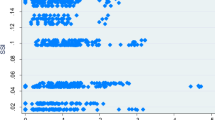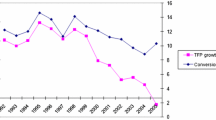Abstract
This paper analyses the impact on sectoral labour productivity growth caused by the increase in the use of temporary employment contracts in Spain over the period 1987–2000. With this aim, we estimate a production function model in which effective labour is represented by the shares of permanent, temporary and self-employed workers. Results suggest that productivity growth has been slowed down by the use of temporary contracts for regular jobs and that this has not been affected by compositional changes in activity over the period. However, this effect has only been detected in the manufacturing and energy sector, in contrast to low-technology low-human capital sectors like construction and hospitality.






Similar content being viewed by others
Notes
The new temporary contracts allow hiring employees to perform regular activities (whereas previous temporary contracts were mainly seasonal) and entail much lower dismissal costs than permanent contracts (see Dolado et al. 2002).
The 2001 labour market reform contains restrictions on the successive use of temporary contracts, increases in fiscal support for the creation of jobs with new permanent contracts and transitory incentives to convert temporary contracts into permanent ones (OECD 2007, p. 52).
This is an outstanding finding considering the tendency among new employees to have lower than average productivity (Treasury 2004, p. 54).
This result is in line with that presented in the Spanish Economic Report of the President (2007) indicating that if the Spanish economy had maintained the productive structure it had in 1996, the relative decrease in productivity would have been restricted to an average of 0.1 percentage points.
The average weights on GVA and total employment of each sector over the period 1987–2000 are presented in the following Table:
Private non-agricultural sectors
Sector
Employment (%)
GVA (%)
M
28.3
30.8
C
13.3
9.7
H
7.9
7.9
F
11.9
16.3
O
38.5
35.3
Total
100.0
100.0
References
Albert C, Garcia-Serrano C, Hernanz V (2005) Firm-provided training and temporary contracts. Span Econ Rev 7(1):67–88
Anderson TW, Hsiao C (1981) Estimation of dynamic models with error components. J Am Stat Assoc 76:598–606
Arellano M, Bond S (1991) Some tests of specification for panel data: Monte Carlo evidence and an application to employment equations. Rev Econ Stud 58:277–297
Basu S, Kimball MS (1997) Cyclical productivity with unobserved input variation. NBER Working Paper Series 5915. NBER, Cambridge
Baum CF (2006) An introduction to modern econometrics using Stata. Stata Press, College Station
Baum CF, Schaffer ME, Stillman S (2003) Instrumental variables and GMM: estimation and testing. Stata J 3(1):1–31
Bentolila S, Dolado JJ (1994) Labour flexibility and wages: lessons from Spain. Econ Policy 9(18):53–99
Bernard AB, Jones CI (1996) Productivity and convergence across US states and industries. Empir Econ 21:113–135
Booth AL, Dolado JJ, Frank J (2002a) Symposium on temporary work. Introduction. Econ J 112(480, June):F181–F188
Booth AL, Francesconi M, Frank J (2002b) Temporary jobs: stepping stones or dead ends? Econ J 112(480, June):F189–F213
Cameron AC, Trivedi PK (2005) Microeconometrics, methods and applications. Cambridge University Press, New York
Cörvers F (1997) The impact of human capital on labour productivity in manufacturing sectors of the European Union. Appl Econ 29:975–987
Diaz-Mayans MA, Sánchez R (2004) Temporary employment and technical efficiency in Spain. Int J Manpower 25:181–194
Dolado JJ, García-Serrano C, Jimeno JF (2002) Drawing lesson from the boom of temporary jobs in Spain. Econ J 112(480, June):F270–F259
Economic Bureau of the President (2007) Economic report of the President. Ministerio de la Presidencia, Madrid (available at www.la-moncloa.es)
García JI, Rebollo Y (2006) The use of permanent and temporary jobs across Spanish regions: do unit labor costs differentials offer an explanation? Moneda y Crédito 223:85–125
Gardiner B, Martin R, Tyler P (2006) ‘Competitiveness, productivity and economic growth across European regions. In: Martin R, Kitson M, Tyler P (eds) Regional competitiveness. Routledge, Abingdon
Green F (2008) Temporary work and insecurity in Britain: a problem solved? Soc Indic Res 88:147–160
Griliches Z, Hausman JA (1986) Errors in variables in panel data. J Econom 31:93–118
Güell M, Petrolongo B (2006) How binding are legal limits? Transitions from temporary to permanent work in Spain. Labour Econ 14(2):153–183
Haskel J, Martin C (1993) Do skill shortages reduce productivity? Theory and evidence from the United Kingdom. Econ J 103(March):386–394
Hausman JA (1978) Specifications tests in econometrics. Econometrica 46:1251–1272
Hayashi F (2000) Econometrics. Princeton University Press, Princeton
Kiviet J (1995) On bias, inconsistency and efficiency of some estimators in dynamic panel data models. J Econom 68:63–78
Nakamura A, Nakamura M (1998) Model specification and endogeneity. J Econom 83:213–237
OECD (2001) OECD Productivity manual: a guide to the measurement of industry-level and aggregate productivity growth. OECD, Paris
OECD (2005) OECD economic surveys: Spain 2005. OECD, Paris
OECD (2007) Economic policy reforms: going for growth. OECD, Paris
OECD (2008) OECD economic surveys: Spain 2008. OECD, Paris
Pagan AR, Hall D (1983) Diagnostic tests as residual analysis. Econom Rev 2:159–218
Roodman D (2006) How to do xtabond2: an introduction to ‘difference’ and ‘system’ GMM in Stata. Working paper 103, center for global development Washington
Sánchez R, Toharia L (2000) Temporary workers and productivity: the case of Spain. Appl Econ 32:583–591
Treasury HM (2004) Microeconomic reform in Britain. Delivering opportunities for all. Palgrave Macmillan, New York
Villaverde J, Maza A (2008) Productivity convergence in the European regions, 1980–2003: a sectoral and spatial approach. Appl Econ 40:1299–1313
Wu D (1973) Alternative tests of independence between stochastic regressors and disturbances. Econometrica 41:733–750
Acknowledgements
The authors wish to thank the editor, an associate editor and the referees for valuable comments that helped to substantially improve the paper. Financial support from the Centro de Estudios Andaluces (CentrA) is also gratefully acknowledged (grant ECOD1.05/036).
Author information
Authors and Affiliations
Corresponding author
Appendix
Appendix
The data used was constructed using the following statistical documents:
-
Spanish Regional Accounts 1995 database (Spanish Institute of Statistics, INE).
-
Spanish Regional Accounts 1986 database; Linked series 1986–1996 (INE).
-
Active Population Survey (microdata, years from 1987 to 2000) (INE).
-
Capital stock in Spain and its regional distribution (1964–2002). BBVA Foundation.
In line with the European System of National Accounts (ESA-95) the Spanish Regional Accounts introduced a change in the concept of Total Employment and Gross Value Added (GVA). From 1995 onwards, data on employment refer to the number of jobs filled and not to the number of workers employed, and data on output refers to GVA at base prices and not to the GVA at factor cost, as was the case before. For this reason, from 1987 onwards a linked series was obtained for the number of jobs in each region and sector corresponding to salaried and non-salaried (self-employed) workers. This procedure has been also applied to estimate a linked series of Gross Value Added at factor cost (GVAfc), as the sum of Compensation of Employees and Gross Operating Surplus/Mixed Income for each year, sector and region.
Microdata from the Active Population Survey (APS) from the INE has also been used to estimate the share of workers with permanent and temporary contracts, the mean years of schooling of the workforce and the mean weekly hours worked by employees in each sector and region. Data relating to physical capital stock was calculated from the BBVA foundation database as the total capital stock of private sector activities minus the residential capital. The Gross Fixed Capital Formation (GFCF) comes from the same source. All the series are expressed in thousands euros at the 1990 value.
Rights and permissions
About this article
Cite this article
Ortega, B., Marchante, A.J. Temporary contracts and labour productivity in Spain: a sectoral analysis. J Prod Anal 34, 199–212 (2010). https://doi.org/10.1007/s11123-010-0185-z
Published:
Issue Date:
DOI: https://doi.org/10.1007/s11123-010-0185-z
Keywords
- Labour productivity
- Labour market segmentation
- Aggregate production function
- Sectoral analysis
- Temporary contracts




